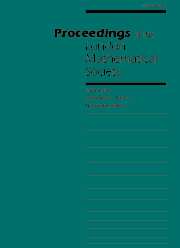Crossref Citations
This article has been cited by the following publications. This list is generated based on data provided by
Crossref.
Bryant, R.M.
and
Schocker, Manfred
2007.
Factorisation of Lie resolvents.
Journal of Pure and Applied Algebra,
Vol. 208,
Issue. 3,
p.
993.
Stöhr, Ralph
2008.
Bases, filtrations and module decompositions of free Lie algebras.
Journal of Pure and Applied Algebra,
Vol. 212,
Issue. 5,
p.
1187.
Bryant, R. M.
and
Johnson, Marianne
2008.
Lie powers and Witt vectors.
Journal of Algebraic Combinatorics,
Vol. 28,
Issue. 1,
p.
169.
Johnson, Marianne
and
Stöhr, Ralph
2011.
Lie Powers and Pseudo-Idempotents.
Canadian Mathematical Bulletin,
Vol. 54,
Issue. 2,
p.
297.
Li, J. Y.
Lei, F. C.
and
Wu, J.
2011.
Module structure on Lie powers and natural coalgebra-split sub-Hopf algebras of tensor algebras.
Proceedings of the Edinburgh Mathematical Society,
Vol. 54,
Issue. 2,
p.
467.
Papistas, A.I.
2011.
On Lie powers of the augmentation ideal in characteristic 2.
Journal of Algebra,
Vol. 342,
Issue. 1,
p.
53.
BRYANT, R. M.
and
JOHNSON, MARIANNE
2012.
A modular version of Klyachko's theorem on Lie representations of the general linear group.
Mathematical Proceedings of the Cambridge Philosophical Society,
Vol. 153,
Issue. 1,
p.
79.
Erdmann, Karin
Lim, Kay Jin
and
Tan, Kai Meng
2014.
The Complexity of the Lie Module.
Proceedings of the Edinburgh Mathematical Society,
Vol. 57,
Issue. 2,
p.
393.
Bryant, Roger M.
Danz, Susanne
Erdmann, Karin
and
Müller, Jürgen
2015.
Vertices of Lie modules.
Journal of Pure and Applied Algebra,
Vol. 219,
Issue. 11,
p.
4816.
Fang, Fuquan
Lei, Fengchun
and
Wu, Jie
2015.
The Symmetric Commutator Homology of Link Towers and Homotopy Groups of 3-Manifolds.
Communications in Mathematics and Statistics,
Vol. 3,
Issue. 4,
p.
497.
JOHNSON, MARIANNE
2017.
L. G. KOVÁCS’ WORK ON LIE POWERS.
Journal of the Australian Mathematical Society,
Vol. 102,
Issue. 1,
p.
9.
Metaftsis, V.
and
Papistas, A. I.
2017.
On the McCool groupM3and its associated Lie algebra.
Communications in Algebra,
Vol. 45,
Issue. 3,
p.
1076.
Donkin, Stephen
2019.
Some remarks on tilting modules, double centralisers and Lie modules.
Journal of Algebra,
Vol. 526,
Issue. ,
p.
188.
Lim, Kay Jin
2023.
Modular idempotents for the descent algebras of type A and higher Lie powers and modules.
Journal of Algebra,
Vol. 628,
Issue. ,
p.
98.

